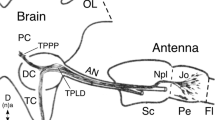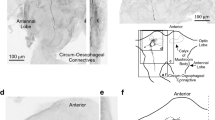Summary
-
1.
The terminal ganglion ofLocusta migratoria contains a number of non-giant, wind-sensitive, ascending and local interneurones. Six ascending (Figs. 1, 2) and 6 local (Figs. 6, 7) interneurones have been identified morphologically on the basis of intracellular stains with Lucifer Yellow.
-
2.
The physiological responses of the various cell types were recorded as the cerci were exposed to sound, wind, or electrical stimulation (Figs. 3, 8). Some cells summate the input from both cerci (Fig. 3), while others are excited by input from one side and inhibited by input from the other (Fig. 8). Conduction velocities for several non-giant ascending interneurones range from 1.5 m/s (cell 1) −2.1 m/s (cell 25).
-
3.
The morphologies and physiological responses of giant (GIN 1) and non-giant ascending interneurones (cells la, b) with somata in cluster 1 of neuromere 9 were compared using simultaneous intracellular recordings (Figs. 2A, 4). These neurones have very similar dendritic arborizations (Fig. 4A, B), and respond almost identically to cercal stimulation (Fig. 4Ci), but there do not appear to be any connections with GIN 1 (Fig. 4Cii, iii).
-
4.
The morphology (Fig. 5A, C), and response to cercal stimulation by wind (Fig. 5B) of a nongiant interneurone (cell 7) with its soma in cluster 1 of segment 8 (Fig. 5), are very similar to those of cluster 1 cells such as GIN 1 in segment 9.
-
5.
Of the 6 local interneurones (Figs. 6, 7) all except one (cell 9) have bilateral arborizations which may extend over several neuromeres within the ganglion (cells 10, 22). Several of the interneurones (cells 5, 9, 24) do not produce action potentials in response to cercal stimulation (Figs. 8, 10) or injection of depolarizing current (Fig. 11).
-
6.
Simultaneous recordings from pairs of interneurones demonstrate that giants and locals (GIN 2/cell 5; GIN 1/cell 9), as well as different local interneurones (cell 24/cell 5), receive input from the same wind-sensitive filiform afferent (Fig. 9).
-
7.
Local interneurones 5 and 22 are in different neuromeres of the terminal ganglion but have a similar gross morphology (Figs. 6, 7, 10). Cell 5, however, has arborizations projecting into both posterior cercal glomeruli (Fig. 7 A, inset), whereas only the ipsilateral branches of cell 22 extend posteriorly to the cercal glomerulus (Fig. 10C). Physiologically, cell 5 is depolarized by wind directed at both cerci (Fig. 10 A), cell 22 mainly by wind directed at the ipsilateral cercus (Fig. 10C). Cell 5 does not produce action potentials in response to wind whereas cell 22 does.
-
8.
Cell 5 occurs as a bilateral pair in the terminal ganglion (Figs. 7B, inset; 11). Simultaneous recordings of the bilateral homologues show that they share the input of at least one wind-sensitive filiform afferent (Fig. 11D), and that there are no connections between them (Fig. 11E). Simultaneous penetrations of local interneurone 5 and giant interneurones demonstrate a short-latency excitatory connection from GIN 3 to cell 5 (Fig. 12 A), and a long-latency excitatory connection from GIN 2 to cell 5.
-
9.
The roles of giant and non-giant interneurones in transmitting information to thoracic motor centres are discussed.
Similar content being viewed by others
Abbreviations
- Ant :
-
anterior
- CNS :
-
central nervous system
- C1a, b, c :
-
cluster 1 cell a, b, c
- DCIII :
-
dorsal commissure III
- EPSP :
-
excitatory postsynaptic potential
- GIN :
-
giant interneurone
- IPSP :
-
inhibitory postsynaptic potential
- LDT :
-
lateral dorsal tract
- VIT :
-
ventral intermediate tract
- VNC :
-
ventral nerve cord
References
Boyan GS, Ball EE (1986) Wind-sensitive interneurones in the terminal ganglion of praying mantids. J Comp Physiol A 159:773–789
Boyan GS, Ball EE (1989a) Parallel inputs shape the response of a giant interneurone in the cercal system of the locust. J Insect Physiol 35:305–312
Boyan GS, Ball EE (1989b) The wind-sensitive cercal receptor/giant interneurone system of the locust,Locusta migratoria. II. Physiology of giant interneurones. J Comp Physiol A 165:511–521
Boyan GS, Ball EE (1989c) The wind-sensitive cercal receptor/giant interneurone system of the locust,Locusta migratoria. III. Cercal activation of thoracic motor pathways. J Comp Physiol A 165:523–537
Boyan GS, Williams JLD, Ball EE (1989) The wind-sensitive cercal receptor/giant interneurone system of the locust,Locusta migratoria. I. Anatomy of the system. J Comp Physiol A 165:495–510
Camhi JM (1980) The escape system of the cockroach. Sci Am 243:144–157
Camhi JM, Tom W, Volman S (1978) The escape behavior of the cockroachPeriplaneta americana. II. Detection of natural predators by air displacement. J Comp Physiol 128:203–212
Collin SP (1985) The central morphology of the giant interneurons and their special relationship with the thoracic motorneurons in the cockroach,Periplaneta americana (Insecta). J Neurobiol 16:249–267
Cook PM (1951) Observations on giant fibres of the nervous system ofLocusta migratoria. Q J Micros Sci 92:297–305
Dagan D, Parnas I (1970) Giant fibre and small fibre pathways involved in the evasive response of the cockroach,Periplaneta americana. J Exp Biol 52:313–324
Daley DL, Vardi N, Appignani B, Camhi JM (1981) Morphology of the giant interneurons and cercal nerve projections of the American cockroach. J Comp Neurol 196:41–52
Dorsett DA (1980) Design and function of giant fibre systems. Trends Neurosci 3:205–208
Edwards JS, Palka J (1974) The cerci and abdominal giant fibres of the house cricketAcheta domesticus. I. Anatomy and physiology of normal adults. Proc R Soc Lond B 185:83–103
Farley RD, Milburn NS (1969) Structure and function of the giant fibre system in the cockroach,Periplaneta americana. J Insect Physiol 15:457–476
Jacobs GA, Murphey RK (1987) Segmental origins of the cricket giant interneuron system. J Comp Neurol 265:145–157
Kobashi M, Yamaguchi T (1984) Local non-spiking interneurons in the cercus-to-giant interneuron system of crickets. Naturwissenschaften 71:154–155
Kondoh Y, Hisada M (1986) Regional specialization in synaptic input and output in an identified local nonspiking interneuron of the crayfish revealed by light and electron microscopy. J Comp Neurol 251:334–348
Krenz WD, Reichert H (1985) Lateralized inhibitory input to an identified nonspiking local interneuron in the crayfish mechanosensory system. J Comp Physiol A 157:499–507
Mendenhall B, Murphey RK (1974) The morphology of cricket giant interneurons. J Neurobiol 5:565–580
Pearson KG, Boyan GS, Bastiani M, Goodman CS (1985) Heterogeneous properties of segmentally homologous interneurons in the ventral nerve cord of locusts. J Comp Neurol 233:133–145
Popov AV, Markovich AM, Andjan AS (1978) Auditory interneurons in the prothoracic ganglion of the cricket,Gryllus bimaculatus deGeer. I. The large segmental auditory neuron (LSAN). J Comp Physiol 126:183–192
Reichert H, Wine JJ (1982) Neural mechanisms for serial order in a stereotyped behaviour sequence. Nature 296:86–87
Reichert H, Wine JJ (1983) Coordination of lateral giant and non-giant systems in crayfish escape behavior. J Comp Physiol 153:3–15
Reichert H, Plummer MR, Hagiwara G, Roth RL, Wine JJ (1982) Local interneurons in the terminal abdominal ganglion of the crayfish. J Comp Physiol 149:145–162
Reichert H, Plummer MR, Wine JJ (1983) Identified nonspik-ing local interneurons mediate nonrecurrent, lateral inhibition of crayfish mechanosensory interneurons. J Comp Physiol 151:261–276
Ritzmann RE (1984) The cockroach escape response. In: Eaton RC (ed) Neural mechanisms of startle behavior. Plenum, New York London, pp 93–131
Ritzmann RE, Camhi JM (1978) Excitation of leg motor neurons by giant interneurons in the cockroachPeriplaneta americana. J Comp Physiol 125:305–316
Ritzmann RE, Pollack AJ (1981) Motor responses to paired stimulation of giant interneurons in the cockroachPeriplaneta americana. I. The dorsal giant interneurons. J Comp Physiol 143:61–70
Ritzmann RE, Pollack AJ (1986) Identification of thoracic interneurons that mediate giant interneuron-to-motor pathways in the cockroach. J Comp Physiol A 159:639–654
Ritzmann RE, Pollack AJ, Tobias ML (1982) Flight activity mediated by intracellular stimulation of dorsal giant interneurons of the cockroachPeriplaneta americana. J Comp Physiol 147:313–322
Ritzmann RE, Tobias ML, Fourtner CR (1980) Flight activity initiated via giant interneurons of the cockroach: evidence for bifunctional trigger interneurons. Science 210:443–445
Rowell CHF, Dorey AE (1967) The number and size of axons in the thoracic connectives of the desert locust,Schistocerca gregaria Forsk. Z Zellforsch 83:288–294
Seabrook WD (1970) The structure of the terminal ganglionic mass of the locust,Schistocerca gregaria (Forskål). J Comp Neurol 138:63–86
Selverston AI, Kleindienst HU, Huber F (1985) Synaptic connectivity between cricket auditory interneurons as studied by selective photoinactivation. J Neurosci 5:1283–1292
Shankland M, Goodman CS (1982) Development of the dendritic branching pattern of the medial giant interneuron in the grasshopper embryo. Dev Biol 92:489–506
Shimozawa T, Kanou M (1984a) Varieties of filiform hairs: range fractionation by sensory afferents and cercal interneurons of a cricket. J Comp Physiol A 155:485–493
Shimozawa T, Kanou M (1984b) The aerodynamics and sensory physiology of range fractionation in the cercal filiform sensilla of the cricketGryllus bimaculatus. J Comp Physiol A 155:495–505
Wine JJ (1984) The structural basis of an innate behavioural pattern. J Exp Biol 112:283–319
Wohlers DW, Huber F (1978) Intracellular recording and staining of cricket auditory interneurons (Gryllus campestris L.,Gryllus bimaculatus DeGeer). J Comp Physiol 127:11–28
Wohlers DW, Huber F (1985) Topographical organization of the auditory pathway within the prothoracic ganglion of the cricketGryllus campestris L. Cell Tissue Res 239:555–565
Zhantiev RD, Korsunovskaja OS (1983) Structure and functions of two auditory neurons in the bush cricket,Tettigonia cantans Fuess. (Orthoptera, Tettigoniidae). Entomol Revue 62:462–468 (in Russian)
Author information
Authors and Affiliations
Rights and permissions
About this article
Cite this article
Boyan, G.S., Williams, J.L.D. & Ball, E.E. The wind-sensitive cercal receptor/giant interneurone system of the locust,Locusta migratoria . J. Comp. Physiol. 165, 539–552 (1989). https://doi.org/10.1007/BF00611240
Accepted:
Issue Date:
DOI: https://doi.org/10.1007/BF00611240




